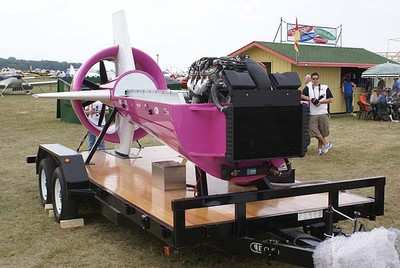Munro & Associates Display Ducted-Fan System
by ANN Correspondent Evan Sweetman
The future of General Aviation may very well be at Oshkosh next
year... and if Sandy Munro and his company -- Munro &
Associates -- has anything to say about it, they'll point to their
concept of a ducted-fan aircraft powered by an automotive
engine.

The prototype, called Paradigm, is on display at Oshkosh this
year, and running two shows a day. Munro's concept is based around
the idea that a car engine requires much less maintenance than an
aero engine.
"The way we see it a car engine is good for about 150,000 miles.
We figure this engine is doing the equivalent of 35 miles per hour,
so the engine should last about 3,000 hours. But the engine only
costs $5,000 out of the crate. That's cheaper and easier than
rebuilding an engine," Munro said.
The basic concept behind Paradigm is to create an aircraft that
is user- and eco-friendly, quiet and safe. Using the automotive
engine will not only cut down on noise, but will also allow the
aircraft to either run on unleaded gas or ethanol, depending on the
engine they use in the production model.
Paradigm will fly with Highway in the Sky and automatic plane
technologies. A new artificial horizon system has also been
developed by Munro which uses a laser to project a red line across
the instrument panel.
"This could also be used to print warning messages to the pilot,"
Munro said. "This is the sort of stuff that Kennedy needed."
Munro says the ducted-fan pusher configuration of the engine
will increase safety of Paradigm as a family aircraft.
His concern was mothers would not want children near a standard
tractor propeller. The ducted fan also will assist in reducing
noise.
While Munro has met with the FAA as recently as March and later
last year in November, he will have to meet with them again as GM,
who supplied the V-6 Corvette engine being used at Oshkosh, has
backed out of the program for unspecified reasons.
As a result, Munro has been pursuing Japanese car manufacturers.
He has confidence in their support.
"The Japanese see their business differently. They say they are in
the 'Transportation' industry, and not just the car industry,"
Munro said.
Munro is trying to learn as much as possible from the engines
they have.
"Last year we tore apart about forty or fifty car engines to
find new features," Munro said.
He believes the engine will need to run at approximately 3500rpm
producing 900lbs of thrust to fly. 4000rpm would be the optimal
full-power for the engine, providing 1200lbs of thrust.
The engine on display at Oshkosh idles at 650rpm, and for the
display he bumps it up to 1200rpm to demonstrate the amount of
sound the fan produces. He has the radiator fan shut off for the
demonstration as it doubles the noise level. As it is, he can speak
clearly over the sound of the fan and be heard from 10 yards
away.
Inspiration for the design came from the Republic Sea-Bee. It is
the simplistic construction of tubular aluminum and spot-welding of
the Sea-Bee that Munro wants to copy for Paradigm. These were the
same design features which led to the FAA halting production of the
Sea-Bee.
According to Munro, when his team took apart a SeaBee they found
no structural problems in sealed parts of the aircraft. When they
spoke to SeaBee pilots, they found the only issue with the aircraft
was structural fatigue below the engine.
"When we told them most of the airframe was spot-welded, they
were surprised. They had no idea," Munro said.

The issue Munro faces in the near future is finding a financial
backer for the airframe. "I don't just want money from anyone. I
want someone who wants to make a change, someone who wants to leave
a legacy," Munro said.
He believes once Paradigm enters production, his company will be
able to sell in the range of 60,000 aircraft.
 ANN's Daily Aero-Term (12.19.25): Ultrahigh Frequency (UHF)
ANN's Daily Aero-Term (12.19.25): Ultrahigh Frequency (UHF) NTSB Prelim: Cirrus Design Corp SR22T
NTSB Prelim: Cirrus Design Corp SR22T Classic Aero-TV: The Red Tail Project--Carrying the Torch of the Tuskegee Airmen
Classic Aero-TV: The Red Tail Project--Carrying the Torch of the Tuskegee Airmen Aero-News: Quote of the Day (12.19.25)
Aero-News: Quote of the Day (12.19.25) Airborne 12.17.25: Skydiver Hooks Tail, Cooper Rotax Mount, NTSB v NDAA
Airborne 12.17.25: Skydiver Hooks Tail, Cooper Rotax Mount, NTSB v NDAA




